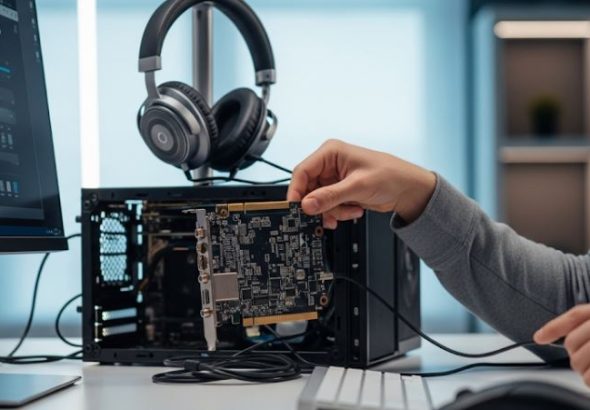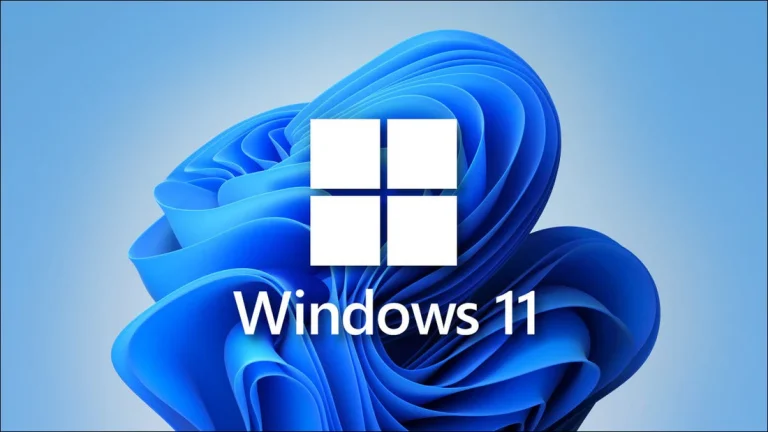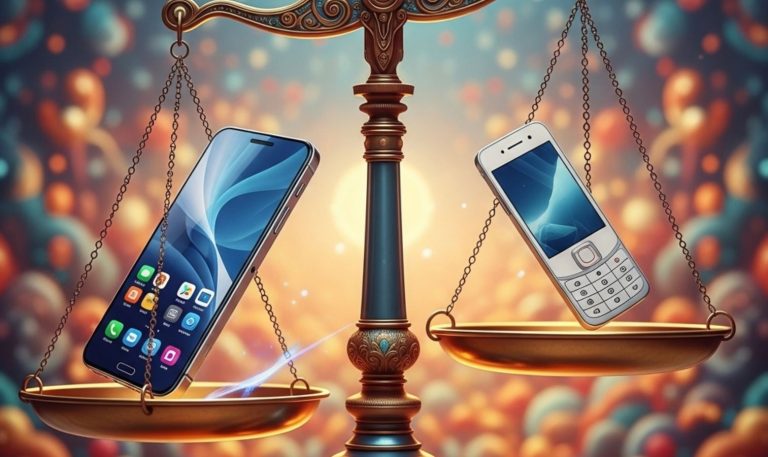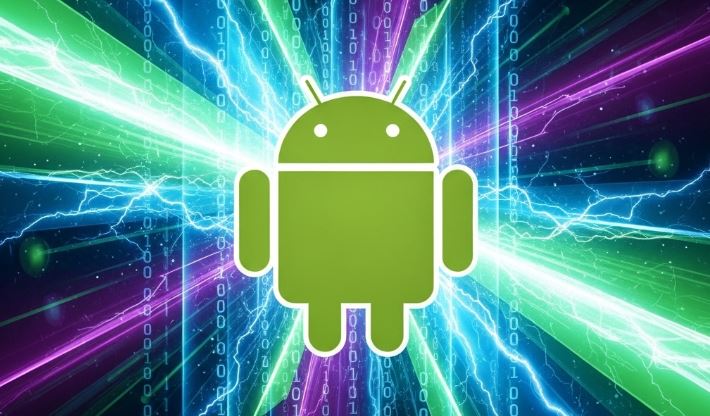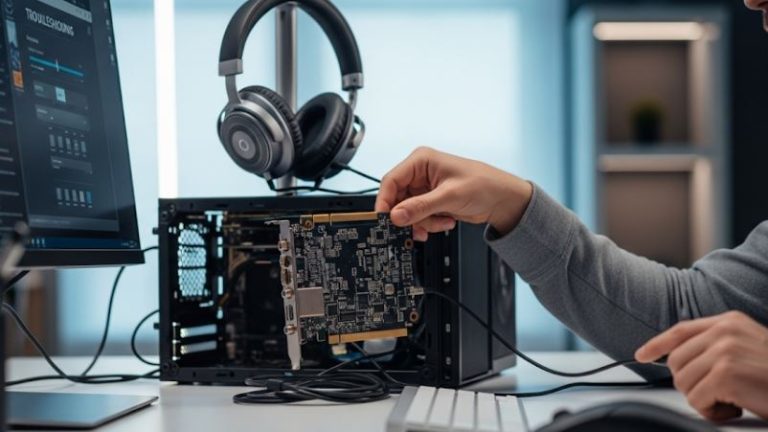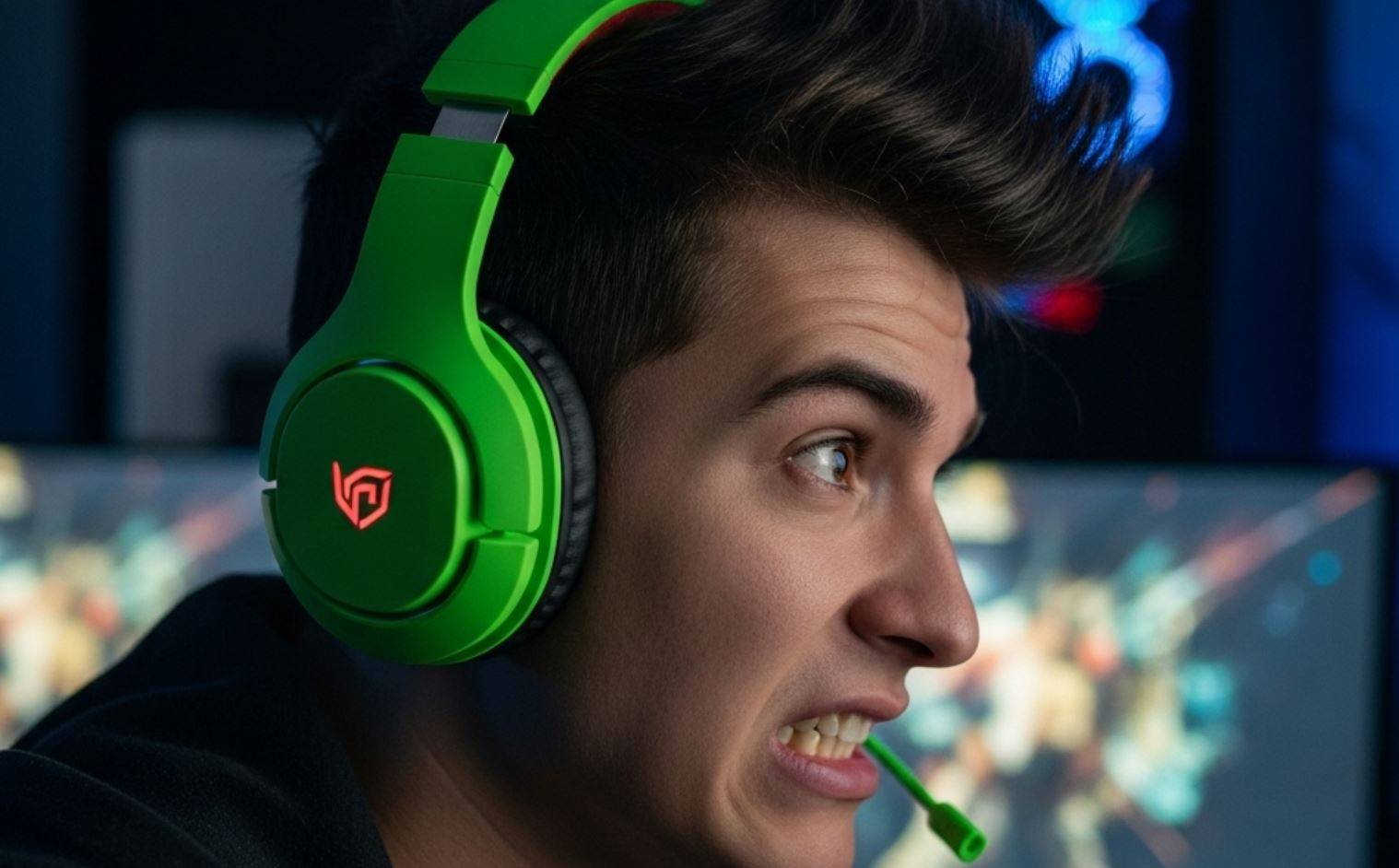
That slight, yet often infuriating, mismatch between what you see on screen and what you hear through your headphones – that’s audio latency, sometimes referred to as audio delay or lag. Whether you’re a competitive gamer where split-second reactions count, a movie enthusiast annoyed by out-of-sync dialogue, or a musician trying to record, headphone audio latency can be a significant source of frustration. This article delves deep into the phenomenon of headphone audio latency, exploring its causes, how it’s perceived, and what can be done to minimize it.
What Exactly is Headphone Audio Latency?
At its core, audio latency is the time delay between when an audio signal is generated by a source device (like a smartphone, computer, or gaming console 💻) and when it’s actually reproduced by your headphones and perceived by your ears. This delay is measured in milliseconds (ms).
While a certain amount of latency is inherent in any digital audio processing chain, it becomes problematic when it crosses a perceptible threshold. For general audio listening, delays below 100ms might be tolerable for some, but for tasks requiring precise synchronization, like gaming or video editing, even delays as small as 30-50ms can be noticeable and detrimental.
The human brain is remarkably adept at detecting discrepancies between visual and auditory cues. When these are out of sync, it can break immersion, cause confusion, or lead to a generally unpleasant experience.
The Primary Culprits: Sources of Headphone Audio Delay
Headphone audio latency isn’t caused by a single factor but is often the cumulative result of several processing steps and technological limitations. Let’s break down the most significant contributors:
1. Wireless Technologies: The Main Contender 📶
Wireless headphones, particularly Bluetooth models, are the most common culprits when it comes to noticeable audio latency. This is due to the complex processes involved in transmitting audio wirelessly:
- Encoding: The source device (e.g., your phone) must encode the digital audio into a format suitable for wireless transmission. This encoding process takes time.
- Transmission: The encoded audio data is then transmitted wirelessly to the headphones. While radio waves travel at the speed of light, the protocol itself introduces delays.
- Reception and Buffering: The headphones receive the wireless signal and often buffer a small amount of data to ensure a continuous stream, especially in environments with potential interference.
- Decoding: The headphones must then decode the received audio data back into an analog signal that can drive the speakers. This decoding process also takes time.
- Digital-to-Analog Conversion (DAC): The decoded digital signal is converted into an analog signal by the DAC within the headphones.
- Amplification: The analog signal is amplified to drive the headphone speakers.
The most significant variable within Bluetooth audio is the Bluetooth codec used. A codec is an algorithm used to compress and decompress digital audio data. Different codecs have varying levels of compression, audio quality, and, crucially, latency.
- SBC (Subband Codec): This is the mandatory, baseline codec for all A2DP (Advanced Audio Distribution Profile) stereo Bluetooth headphones. It’s universally compatible but generally offers the highest latency (often 150-250ms, sometimes higher) and the most variable audio quality.
- AAC (Advanced Audio Coding): Favored by Apple devices, AAC can offer better sound quality than SBC at similar bitrates. Its latency can be quite variable; on Apple devices, it’s often optimized for lower latency (around 100-150ms), but on Android, performance can differ significantly due to less consistent implementation and can sometimes be higher than SBC.
- aptX: Developed by Qualcomm, aptX offers better sound quality than SBC and generally lower latency (typically around 60-100ms). It’s widely available on Android devices and many wireless headphones. You need both the source and the headphones to support aptX for it to be active.
- aptX Low Latency (aptX LL): Specifically designed to minimize audio delay, aptX LL aimed for latency below 40ms, making it ideal for gaming and video. However, it required dedicated hardware support and has been largely superseded by aptX Adaptive. Finding new devices with aptX LL is becoming increasingly difficult.
- aptX HD: This codec focuses on high-fidelity audio, offering 24-bit audio quality. While sound quality is excellent, its latency is generally similar to or slightly higher than standard aptX (around 100-150ms), as the priority is quality over speed.
- aptX Adaptive: This is a newer, more flexible codec from Qualcomm. It dynamically adjusts the bitrate to balance audio quality, latency, and connection stability based on the RF environment and content. It can achieve relatively low latency (often quoted around 50-80ms) and is backward compatible with standard aptX.
- LC3 (Low Complexity Communications Codec): Part of the new Bluetooth LE Audio standard, LC3 is designed to deliver good audio quality even at low bitrates and offers improvements in latency compared to SBC. It is expected to become more widespread as LE Audio adoption grows. Its latency figures can be significantly lower, potentially in the 20-50ms range, depending on implementation. Learn more about Bluetooth LE Audio and LC3 from the official Bluetooth SIG website.
- Proprietary 2.4GHz RF: Many gaming headsets use their own proprietary 2.4GHz wireless protocols via a USB dongle. These connections are generally optimized for low latency, often achieving delays under 30ms, which is crucial for competitive gaming. They bypass the standard Bluetooth stack on the computer or console, allowing for a more direct and faster audio pipeline.
Key takeaway for wireless: The codec used is paramount. Even if your headphones support a low-latency codec, your source device must also support it. The connection will always default to the highest quality/lowest latency codec supported by both devices.
2. Wired Connections: Not Always Latency-Free
While wired headphones are generally the go-to solution for minimal latency, they are not entirely immune, though the delays are usually far less perceptible than with Bluetooth.
- Analog (3.5mm Jack): A direct analog connection from a headphone jack to passive headphones introduces negligible latency from the connection itself. However, the source device still performs digital-to-analog conversion (if the source is digital) and other processing, which can contribute a few milliseconds.
- USB/Lightning Headphones: Headphones that connect via USB or Lightning contain their own internal DAC (Digital-to-Analog Converter) and amplifier. The audio data is sent digitally to the headphones, and the conversion happens there. While this often results in better audio quality consistency across devices, the internal processing (DAC, any DSP features like EQ or virtual surround) can introduce a small amount of latency, usually well under 20ms but still a factor.
3. Source Device Processing 💻📱
The device generating the audio (your phone, PC, tablet, or console) plays a significant role in the overall latency equation:
- Operating System Audio Stack: The OS itself has an audio processing pipeline that handles mixing audio from different applications, applying system-wide effects, and routing audio to the correct output. This stack inherently introduces some delay.
- Drivers: Audio drivers are software that allows the OS to communicate with the audio hardware. Poorly optimized or outdated drivers can contribute to increased latency.
- Application-Level Buffering: Many applications (music players, video players, games) use audio buffers to prevent glitches or dropouts. Larger buffers ensure smooth playback but increase latency. Some applications, especially games, offer settings to adjust buffer sizes.
- CPU Load: If the device’s CPU is heavily loaded with other tasks, audio processing might be delayed, leading to increased latency or even stuttering.
- Software-Based Audio Enhancements: Any software features like equalizers, virtual surround sound, or noise reduction running on the source device will add processing time and thus latency.
4. Headphone Internal Processing
Modern headphones, especially premium wireless and USB models, are packed with technology that can inadvertently add to the audio delay:
- Digital-to-Analog Converters (DACs): As mentioned, the process of converting a digital audio signal to an analog one that can drive the headphone speakers takes time. The complexity and quality of the DAC can influence this.
- Amplifiers: While primarily boosting the signal, amplifiers also have a processing path.
- Digital Signal Processing (DSP): This is a major factor in many contemporary headphones. DSP is used for:
- Active Noise Cancellation (ANC): ANC systems use microphones to capture ambient noise, then generate an inverse sound wave to cancel it out. This complex real-time processing adds latency.
- Equalization (EQ): Custom EQ profiles or adaptive EQ involve digital filtering, adding processing time.
- Spatial Audio / Virtual Surround Sound: Creating a 3D soundscape from a stereo or multichannel source requires significant DSP calculations, which contribute to latency.
- Transparency Modes: Similar to ANC, these modes use microphones to pass through external sounds, which also involves processing.
The more sophisticated the features packed into your headphones, the more internal processing is likely occurring, potentially increasing latency.
5. Environmental Factors (Mainly for Wireless) 🌍
For wireless headphones, the surrounding environment can also impact performance and indirectly affect latency by causing instability that might lead to increased buffering:
- Distance: The farther your wireless headphones are from the source device, the weaker the signal becomes, potentially leading to dropouts or increased efforts by the system to maintain a stable link, sometimes affecting latency.
- Physical Obstructions: Walls, furniture, and even your own body can impede wireless signals, especially for Bluetooth.
- Radio Frequency (RF) Interference: Bluetooth and many proprietary wireless systems operate in the 2.4GHz frequency band, which is also used by Wi-Fi routers, microwaves, other Bluetooth devices, and even some cordless phones. High RF interference can lead to packet loss, retransmissions, and overall instability, which can force codecs to less aggressive modes or increase buffering, thereby increasing perceived latency.
Measuring and Perceiving Latency
Latency is typically measured from the moment a sound is initiated on the source (e.g., a gunshot in a game) to the moment it’s audible through the headphones. Specialized equipment is used for precise measurements, often involving a microphone placed near the earcup and software to compare the original signal with the recorded output.
Perceptibility varies among individuals and depends heavily on the application:
- Below 20ms: Generally considered imperceptible for most tasks, including professional audio work.
- 20-40ms: Often considered excellent for gaming and lip-sync in videos. This is the target for many low-latency gaming headsets.
- 40-100ms: May be noticeable in fast-paced gaming or for lip-sync by sensitive individuals. Tolerable for casual video watching for many.
- 100-200ms: Lip-sync issues become more apparent. Gaming can feel sluggish. General music listening is usually fine.
- Above 200ms: Significant lag. Videos can be unwatchable due to poor lip-sync. Competitive gaming is severely hampered.
🎯 Strategies to Minimize Headphone Audio Latency
While completely eliminating latency is often impossible, especially with wireless audio, here are several strategies to reduce it to more manageable levels:
-
Choose Wired Headphones: This is the simplest and most effective solution for drastically reducing latency. A direct analog (3.5mm) connection will almost always offer the lowest possible delay. USB-C or Lightning wired headphones are also very good options, with minimal latency.
-
Select Headphones with Low-Latency Wireless Technology:
- For Bluetooth, look for headphones supporting aptX Adaptive or aptX Low Latency (though the latter is becoming rare). The upcoming LC3 codec with Bluetooth LE Audio also promises significant improvements. Always check if your source device supports these codecs too.
- For gaming, consider headsets using proprietary 2.4GHz RF connections with a dedicated USB dongle. These are specifically designed for low-latency performance.
-
Check Codec Compatibility and Active Codec: Ensure your source device (phone, computer) and headphones both support a low-latency codec. Many Android phones allow you to check the active Bluetooth codec in developer options. If you have an aptX LL or Adaptive capable headphone, but your phone only supports SBC or AAC, you won’t get the low-latency benefit.
-
Update Firmware and Drivers:
- Keep your headphone firmware updated. Manufacturers sometimes release updates that improve connection stability or codec performance.
- Ensure your computer’s Bluetooth drivers, audio drivers, and chipset drivers are up to date. For dedicated gaming headsets with dongles, check the manufacturer’s website for specific drivers or software.
-
Optimize Source Device Settings:
- Gaming Mode: Many smartphones and some headphones offer a „Gaming Mode” or „Low Latency Mode.” This mode often prioritizes speed over other factors like power consumption or even minor aspects of audio quality to reduce delay.
- Disable Software Audio Enhancements: Turn off any software-based equalizers, virtual surround sound, or other audio effects on your source device if latency is critical.
- Close Unnecessary Applications: Reduce the CPU load on your source device by closing background apps, which can help ensure audio processing isn’t delayed.
- Adjust Buffer Sizes (Advanced): Some professional audio software or even games might allow you to adjust audio buffer sizes. Smaller buffers reduce latency but increase the risk of audio glitches if the system can’t keep up.
-
Minimize Wireless Interference:
- Reduce the distance between your wireless headphones and the source device.
- Ensure a clear line of sight if possible.
- Move potential sources of 2.4GHz interference (like Wi-Fi routers, microwaves) further away from your audio devices, or try switching your Wi-Fi router to the 5GHz band if your devices support it, to free up the 2.4GHz band.
-
Turn Off Power-Saving Features (Use with Caution): Some aggressive power-saving modes on laptops or phones might throttle CPU performance or Bluetooth radio power, potentially increasing latency. Disabling these might help, but be mindful of battery life.
-
Disable Headphone-Specific Features (If Latency is Critical): If your headphones have features like intensive Active Noise Cancellation or complex DSP-driven spatial audio, and you’re in a situation where latency is absolutely paramount (e.g., critical gaming moment), try temporarily disabling these features if the headphone’s app or controls allow. The impact varies by model, but it’s a potential factor.
When is Latency a Deal-Breaker?
The acceptable level of latency is highly subjective and application-dependent:
- Competitive Gaming 🎮: Even small delays can mean the difference between winning and losing. Gamers often seek latency below 30-40ms.
- Music Production and Performance 🎹: Musicians recording or monitoring themselves need near-zero latency to stay in time. Typically, wired connections and specialized audio interfaces are used.
- Video Editing 🎬: Precise audio-video synchronization is crucial. Editors need to ensure that sounds align perfectly with on-screen events.
- Watching Videos/Movies 🍿: Lip-sync is the most common issue. While some people are more sensitive than others, delays over 100-150ms generally become noticeable and annoying.
- Casual Music Listening: Latency is usually not a significant concern unless you are also watching a music video.
- Voice/Video Calls 📞: While some delay is inherent, excessive latency can make conversations difficult and unnatural.
The Future of Low-Latency Audio
The industry is continually working on improving wireless audio performance. The widespread adoption of Bluetooth LE Audio with the LC3 codec is a significant step forward. LC3 is designed to be more efficient and offer lower latency than SBC and even some older advanced codecs, potentially making sub-50ms latency more common even without proprietary solutions.
Furthermore, advancements in proprietary wireless technologies, particularly for gaming, continue to push the boundaries, aiming for latencies that rival wired connections. Improvements in chipsets, antenna design, and software optimization will also contribute to reducing audio delay across the board.
Conclusion
Headphone audio latency is a complex issue stemming from multiple factors, from the wireless technology and codecs used, to processing on both the source device and within the headphones themselves. While wireless headphones offer unparalleled convenience, they often come with the trade-off of increased audio delay compared to their wired counterparts.
Understanding the causes of this latency allows users to make more informed purchasing decisions and take steps to mitigate the delay. By choosing appropriate hardware, ensuring codec compatibility, and optimizing settings, you can significantly improve your audio-visual experience, whether you’re gaming, watching videos, or listening to music. For the absolute lowest latency, a traditional wired connection remains the most reliable choice. However, as technology evolves, the gap between wired and wireless performance continues to narrow, promising a future with even more responsive wireless audio.

